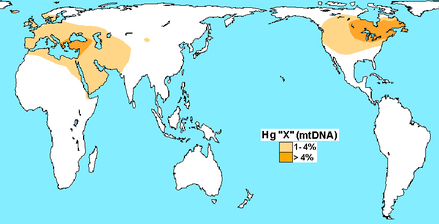The answer is . . . (drumroll): not much.
 Map showing geographical distribution of Haplogroup X among living populations (Wikimedia Commons).
Map showing geographical distribution of Haplogroup X among living populations (Wikimedia Commons). Haplogroup X is found in living populations in Europe, west Asia, and northern North America. Studies in the late 1990s began to ask whether the geographic distribution of Haplogroup X among living populations was telling us something about the origin of at least some New World peoples. A widely-read 1998 popular article titled "Genes May Link Ancient Eurasians, Native Americans" (Science 280(5363):520) helped popularize the idea that peoples from the Near East or Europe contibuted to Native American ancestry. This idea was very popular among Mormons looking for evidence of a migration of Near Eastern peoples to the New World several thousand years ago (it is regarded with less enthusiasm now, especially after the publication of genetic data from Kennewick Man: see this blog post, for example).
The distribution of Haplogroup X has also been proffered as evidence by proponents of the Solutrean Hypothesis (the idea that Paleolithic peoples from Europe migrated to eastern North America around 20,000 years ago). In a 2014 paper ("Solutrean Hypothesis: Genetics, the Mammoth in the Room," World Archaeology 46(5):752-774), Stephen Oppenheimer, Bruce Bradley, and Dennis Stanford argued that
"The mtDNA X2a evidence is more consistent with the Atlantic route and dates suggested by the Solutrean hypothesis and is more parsimonious than the assumption of a single Beringian entry, that assumes retrograde extinction of X in East Eurasia." (from the abstract)
Raff and Bolnick's essay strongly challenges that interpretation, concluding the following (page 301):
"We remain unconvinced by the arguments advanced thus far in favor of a trans-Atlantic migration prior to 1500 cal yr BP or so. As we have discussed, X2a has not been found anywhere in Eurasia, and phylogeography gives us no compelling reason to think it is more likely to come from Europe than from Siberia. Furthermore, analysis of the complete genome of Kennewick Man, who belongs to the most basal lineage of X2a yet identified, gives no indication of recent European ancestry and moves the location of the deepest branch of X2a to the West Coast, consistent with X2a belonging to the same ancestral population as the other founder mitochondrial haplogroups. Nor have any high-resolution studies of genome-wide data from Native American populations yielded any evidence of Pleistocene European ancestry or trans-Atlantic gene flow."
This is an interesting case where, I think, interpretations based initially solely on genetic information from living populations are and will continue to be refined as data are added from prehistoric remains. Genetic data from living populations are great for formulating hypotheses, but they don't actually provide direct evidence about the past -- that has to come materials and skeletons that are actually from the past. Whatever story is "true" has to be consistent with all lines of evidence. Raff and Bolnick (page 301) mention that there are currently no genetic data from Solutrean skeletal material -- I hope someone pursues that in the near future.
As a final aside: it's a bummer that every single paper I discuss in this post is behind a paywall. I can get to them through my university library access, but the public generally can't. A lot of people out there who are not professional academics are interested in these issues and it's a shame we can't make our work more openly available to them. The Raff and Bolnick paper is a great example, I think, of an essay on a technical issue that is written in such a way as to be palatable to a non-technical audience (and when it comes to genetics, I include myself in that audience). I hope that their paper can somehow be made open access so anyone and everyone can read it.
Update (11/7/2015): A copy of Raff and Bolnick's paper can be downloaded from Jennifer Raff's Academia.edu page.


 RSS Feed
RSS Feed
